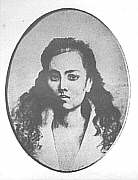
María Clara
Encyclopedia

Noli Me Tangere (novel)
Noli Me Tangere is a novel by Filipino polymath José Rizal and first published in 1887 in Berlin, Germany. Early English translations used titles like An Eagle Flight and The Social Cancer, but more recent translations have been published using the original Latin title.Though originally written in...
, a novel by José Rizal
José Rizal
José Protacio Rizal Mercado y Alonso Realonda , was a Filipino polymath, patriot and the most prominent advocate for reform in the Philippines during the Spanish colonial era. He is regarded as the foremost Filipino patriot and is listed as one of the national heroes of the Philippines by...
, the national hero of the Republic of the Philippines. Maria Clara is the childhood sweetheart
Childhood sweetheart
Childhood sweetheart is a reciprocating phrase for a relationship between young persons, traditionally of the opposite sex occurring in their formative years...
and fiancée of Noli Me Tangere 's hero, Juan Crisóstomo Ibarra y Magsalin, the son of Don Rafael Ibarra. Although raised as Santiago "Kapitan Tiyago" de los Santos’s daughter, Maria Clara is the illegitimate offspring of Father Dámaso, a Spanish
Spanish people
The Spanish are citizens of the Kingdom of Spain. Within Spain, there are also a number of vigorous nationalisms and regionalisms, reflecting the country's complex history....
friar
Friar
A friar is a member of one of the mendicant orders.-Friars and monks:...
, and Doña Pía Alba. Doña Alba is the wife of Kapitan Tiyago, who are both native Filipinos. Father Damaso (also known as Padre Damaso) is known to Maria Clara as a godfather
Godparent
A godparent, in many denominations of Christianity, is someone who sponsors a child's baptism. A male godparent is a godfather, and a female godparent is a godmother...
. Maria Clara never met her mother because Doña Alba died during the delivery of her daughter. She grew under the guidance and supervision of Tía Isabél, Kapitan Tiyago's cousin. While her boyfriend Crisostomo Ibarra was travelling in Europe
Europe
Europe is, by convention, one of the world's seven continents. Comprising the westernmost peninsula of Eurasia, Europe is generally 'divided' from Asia to its east by the watershed divides of the Ural and Caucasus Mountains, the Ural River, the Caspian and Black Seas, and the waterways connecting...
, Kapitan Tiyago sent her to the Beaterio de Santa Clara, a convent where she developed femininity
Femininity
Femininity is a set of attributes, behaviors, and roles generally associated with girls and women. Though socially constructed, femininity is made up of both socially defined and biologically created factors...
under religion. Later in the novel, Maria Clara discovers the truth that Father Damaso is her biological father.
Description
In the novel, Maria Clara is regarded as the most beautiful and widely celebrated lady in the town of San Diego. Maria Clara, being religious, the epitome of virtue, “demure and self-effacing” and endowed with beauty, grace, and charm, was promoted by Rizal as the “ideal image” of a Filipino womanWomen in the Philippines
The role of women in the Philippines is explained based on the context of Filipino culture, standards, and mindsets. The Philippines is described to be a nation of strong women, who directly and indirectly run the family unit, businesses, government agencies and haciendas.Although they generally...
who deserves to be placed on the “pedestal of male honor”. In Chapter 5 of Noli Me Tangere, Maria Clara and her traits were further described by Rizal as an “Oriental decoration” with “downcast” eyes and a “pure soul”.
Basis and adaptation
Rizal based the fictional character of Maria Clara from his real life girlfriend and cousin Leonor RiveraLeonor Rivera
Leonor Rivera–Kipping was the childhood sweetheart, first cousin, and “lover by correspondence” of Philippine national hero José Rizal. Rivera was the “greatest influence” in preventing Rizal from falling in love with other women while Rizal was traveling outside the Philippines...
. Although praised and idolized, Maria Clara's chaste, "masochistic", and "easily fainting" character had also been criticized as the "greatest misfortune that has befallen the Filipina in the last one hundred years". In fashion in the Philippines, Maria Clara's name has become the eponym
Eponym
An eponym is the name of a person or thing, whether real or fictitious, after which a particular place, tribe, era, discovery, or other item is named or thought to be named...
for a Filipino national dress for females known as the Maria Clara gown
Maria Clara gown
The Maria Clara gown is a traditional gown worn by women in the Philippines. This Filipino dress takes its name from María Clara, the mestiza protagonist of the national epic Noli Me Tangere, penned in 1890 by Filipino national hero José Rizal. It has been connected to the Maria Clara character...
, an attire connected to Maria Clara’s character as a maiden who is delicate, feminine, self-assured, and with a sense of identity.
maria clara's song by dr.jose rizal
- Sweet the hours in the native country,
- where friendly shines the sun above!
- Life is the breeze that sweeps the meadows;
- tranquil is death; most tender, love.
- Warm kisses on the lips are playing
- as we awake to mother's face:
- the arms are seeking to embrace her,
- the eyes are smiling as they gaze.
- How sweet to die for the native country,
- where friendly shines the sun above!
- Death is the breeze for him who has
- no country, no mother, and no love!
External links
- Description of María Clara at en.wikibooks.org
- Full text in Tagalog ("Ang Awit ni Maria Clara")
- Full text in Spanish ("Canto de Maria")
- Full text in English ("The Song of Maria Clara")

